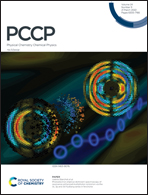An intrinsic room-temperature half-metallic ferromagnet in a metal-free PN2 monolayer†
Abstract
In spintronics, the embodiment of abundance availability, long spin relaxation time, complete spin-polarization and high Curie temperature (TC) in intrinsic metal-free half-metallic ferromagnets (MFHMFs) are highly desirable and challenging. In this work, employing density functional theory, we first propose a dynamically, thermally, and mechanically stable two-dimensional (2D) intrinsic MFHMF, i.e. a MoS2-like PN2 monolayer, which possesses not only completely spin-polarized half-metallicity, but also an above-room-temperature TC (385 K). The half-metallic gap is calculated to be 1.70 eV, which can effectively prevent the spin–flip transition caused by thermal agitation. The mechanism of magnetism in the PN2 monolayer is mainly derived from the p electron direct exchange interaction that separates from usual d-state magnetic materials. Moreover, the robustness of the ferromagnetism and half-metallicity is observed against an external strain and carrier (electron or hole) doping. Surprisingly, electron doping can effectively increase the Curie temperature of the PN2 monolayer. The proposed research work provides an insight that PN2 can be a promising candidate for realistic room-temperature metal-free spintronic applications.



 Please wait while we load your content...
Please wait while we load your content...